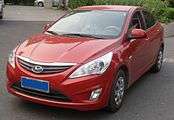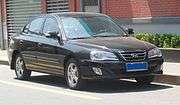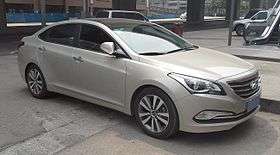Beijing Hyundai
 | |
Native name | 北京现代汽车有限公司 |
|---|---|
| Private joint venture | |
| Industry | Automotive |
| Founded | 18 October 2002 |
| Headquarters | Beijing, China |
Area served | China |
| Products | Automobiles |
| Owner |
Beijing Automotive Group (50%) Hyundai Motor Company (50%) |
Number of employees | 15,000[1] |
| Website |
www |
| Beijing Hyundai | |||||||||||||||||
| Simplified Chinese | 北京现代 | ||||||||||||||||
|---|---|---|---|---|---|---|---|---|---|---|---|---|---|---|---|---|---|
| Traditional Chinese | 北京現代 | ||||||||||||||||
| Literal meaning | Beijing Hyundai | ||||||||||||||||
| |||||||||||||||||
| South Korean name | |||||||||||||||||
| Hangul | 북경현대 | ||||||||||||||||
| Hanja | 北京現代 | ||||||||||||||||
| |||||||||||||||||
Beijing Hyundai Motor Co., Ltd. is an automobile manufacturing company headquartered in Beijing, China, and is joint-venture between Beijing Automotive Group and Hyundai Motor Company. Established in 2002, it manufactures in Shunyi District, a satellite city of Beijing,[2] producing Hyundai-branded automobiles for the Chinese market.
2014 saw the company sell 1,120,000 vehicles.[3] Were it not a subsidiary such sales figures would have placed it as the sixth or seventh most-productive Chinese automaker. It did make the third most-purchased model in 2010 in China, the Elantra.[4]
History
In May 2002, Hyundai Motor and the Beijing Automotive Group signed a memorandum of understanding with the aim of creating a joint venture based around an existing Beijing factory. Hyundai begun to improve the plant's installations,[5] and on 18 October 2002 an equally owned joint venture between the two companies was established. While it was not the first arrangement between a foreign and a domestic automaker, Beijing Hyundai was the first to be approved by the Chinese government after its entry into the World Trade Organisation.[6] Beijing Hyundai initially expanded its production output through importation of key parts from South Korea and the creation of an integrated, Korean-owned supply network inside China.[7][8] As of 2012, average per year production since 2003 stands at roughly 370,000 vehicles,[9] but yearly output has grown over the lifetime of the project.[3]
Products
At least four Hyundai models have been solely sold on the Chinese market. These are: BT01, indigenously designed; Lingxiang (Chinese: 领翔), an interior-and-feature localized Sonata NF; Elantra Yuedong, a localized version of the Elantra; and Verna, a city car.[10] All are tailored to Chinese tastes. The 5th generation Elantra is sold in China as the Langdong,[11] but little localization is likely to have occurred.
Gallery
-

Hyundai Verna RC sedan
-

Hyundai Elantra XD facelift (only in China)
-

Hyundai Elantra Yuedong (only in China)
-

Hyundai Elantra Langdong (only in China)
-

Hyundai Moinca - facelifted 4th-gen Sonata (only in China)
-
Hyundai Sonata NFC (only in China)
-

Hyundai Mistra (only in China)
-

Hyundai Sonata VI
-

Hyundai ix25
-

Hyundai ix35
Shouwang brand
Cheaper[12] products may be sold under a new, China-only brand name, Shouwang.[13] A concept vehicle was shown at car shows in China in 2011 and 2012, but the brand does not appear to have been launched.[14]
Production bases and facilities
As of 2013, the company has at least three production bases[11] as well as an R&D center, all of which are probably in the Linhe Industrial Development Zone of the Shunyi District, a satellite city of Beijing.[15] Two of these produce automobiles and the other, engines.[15]
Its first automobile production base was completed in 2003 and the second in April 2008.[16] Construction on a third Beijing base begun in late 2010 should be complete in the second half of 2012.[17] At least one of these facilities is 17 km from Shunyi Yangzhen.[18]
References
- ↑ "Brief Introduction" (in Chinese). Beijing Hyundai Motor. Retrieved 2015-03-21.
- ↑ For ownership and company information, see BEIJING HYUNDAI OPENS NEW PLANT, ADDS NEW MODEL Hyundai Official Site, 2008-04-11
- For year established and production base location, see "Industrial tourism to Beijing Hyundai Auto Co. Ltd". Information Center of Shunyi District Government. 2011-09-15. Retrieved 2012-05-26.
- 1 2 "Hyundai Motor reveals goals for sales in China". Korean JoongAng Daily. JoongAng Ilbo. Jan 17, 2013. Retrieved 21 September 2013.
- ↑ Top 10 Best-Selling Sedans and SUVs in 2010 chinaautoweb.com, January 14, 2011
- ↑ Oh, Je-Wheon (2010). "Manufacturing Capability and Competitive Strategies of Beijing Hyundai in China". In Abō, Tetsuo. Competing Chinese and Foreign Firms in Swelling Chinese Economy: Competition Strategies for Japanese, Western and Asian Firms. Global Cultural and Economic Research. 5. LIT Verlag Münster. pp. 153–156. ISBN 978-3-8258-1740-4.
- ↑ "Beijing Hyundai Co. , Ltd.". Chinacsrmap.org. Archived from the original on March 4, 2016. Retrieved August 28, 2013.
- ↑ Thun, Eric (2006). "Global Integration and the Challenge of Upgrading". Changing Lanes in China: Foreign Direct Investment, Local Governments, and Auto Sector Development. Cambridge University Press. pp. 238–239. ISBN 978-0-521-84382-9.
- ↑ Doing Business in Beijing By China Knowledge Press Pte Ltd, Page 263 (2nd Ed., "2004 Edition"- 2005)
- ↑ 북경현대 제 2공장 탐방 노트- '현대 스피드' 용어의 산실 [Beijing Hyundai 2nd plant visit notes - birthplace of the term "Hyundai Speed"] (in Korean). Global-autonews.com. December 24, 2012. Archived from the original on September 26, 2013. Retrieved August 28, 2013.
- ↑ For the BT01, see HYUNDAI REVEALS THREE NEW MODELS AT SHANGHAI AUTO SHOW Hyundai Official Site, 2009-04-20
- For the Lingxiang see, Hyundai Motor World: Hyundai Motor Participates in Auto Guangzhou 2008; Ling Xiang (领翔), the NF Sonata model for China, is unveiled for the first time at Auto Guangzhou 2008 Hyundai Official Site, First Quarter 2009, Vol.17 No.62
- For the Yuedong, see BEIJING HYUNDAI OPENS NEW PLANT, ADDS NEW MODEL Hyundai Official Site, 2008-04-11
- For the Verna, see Hyundai Unveils All-New Verna at Beijing Show Hyundai Official Site, 2010-04-23
- 1 2 "Hyundai Motor Unveils China-Exclusive Elantra at the 2012 Beijing Motor Show". Hyundai Motor Company. 2012-04-23. Retrieved January 16, 2013.
- ↑ "Hyundai to launch new sub brand in November". Chinacartimes. October 12, 2011. Archived from the original on 2012-01-16. Retrieved 2012-02-02.
- ↑ "Short Torque". China Daily. 2011-11-28.
- ↑ For 2011 appearance, see de Feyter, Tycho (November 20, 2011). "Beijing-Hyundai Shouwang BHCD-1 at the Guangzhou Auto Show". carnewschina.com. Retrieved January 16, 2013.
- For 2012 appearance, see "Hyundai Shouwang BHCD-1 concept". c|net. CBS Interactive Inc. April 24, 2012. Retrieved January 16, 2013.
- 1 2 Industrial tourism to Beijing Hyundai Auto Co. Ltd Press Release, Information Center of Shunyi District Government, 2009-4-12
- ↑ For first production base, see Beijing Auto Manufacturing Base Press Release, Information Center of Shunyi District Government, 2009-4-10
- For second production base, see BEIJING HYUNDAI OPENS NEW PLANT, ADDS NEW MODEL Hyundai Official Site, 2008-04-11
- ↑ "Short Torque: Hyundai's third facility", China Daily: 19, 2010-12-06
- ↑ Part Overview Beijing Hainachuan Automotive Parts Co., Ltd.